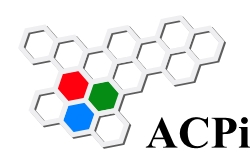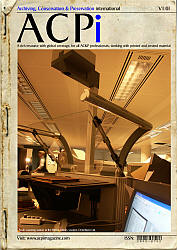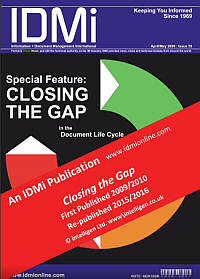|
|
|
Menu: Home | About | Articles | For Sale | Partners | Organisations | Subscribe | Contact Us | Musty
|
ACPi Articles
Articles related to .... |
This page is still under construction. |
|
Archiving Closing the Gap [from IDMi Magazine] |
|
|
|
|
|
Where have all the large-format neg+pos instant films gone?
By ACPi Following a discussion ACPi had with editor John Baker, it transpires that copy techniques may have faltered over the years |
|
|
"Back in the day, ..." he started, so we rolled our eyes
as he continued, "... I was fortunate enough to work as a photo-tech for
Aberdeen University in the
North East of Scotland." He recounts that, "Apart from the main workroom, the
rooms we used were smallish but functional and included 2 fully operational
darkrooms for mono and colour work. The main area housed two 35mm microfilm
cameras for large and medium size originals, a Polaroid MP-4 camera on copy
stand and with a Polaroid 545 back, (below) a Leitz Reprovit, (below-left) and a
Bowens
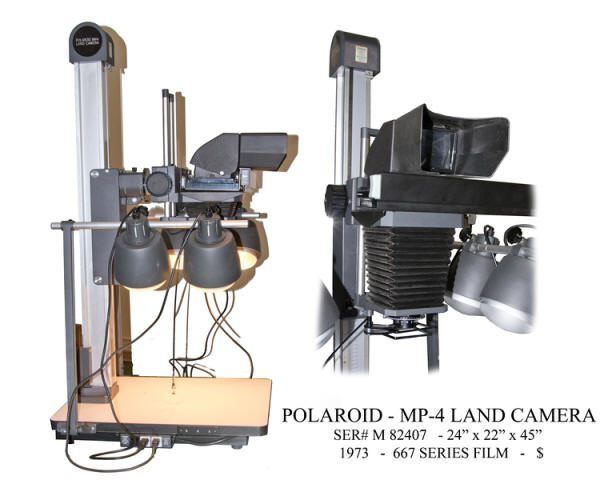
Illumitran. There were various other bits and bobs of kit there too, but the old
memory is a little fuzzy on the detail." (He does manage to recall a
fully-operational and well-used kettle though!)
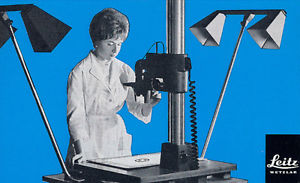 At
the back of this small complex was a large and extremely dim storage area
comprising 2 sets of rolling shelves housing overflow from the Queen Mother
Library stack, and the famous George Washington Wilson Collection of over 40,000
glass plates. Being housed in the basement, the place where all management
consider a darkroom HAS to be, this accounts for the dimness of the light. At
the back of this small complex was a large and extremely dim storage area
comprising 2 sets of rolling shelves housing overflow from the Queen Mother
Library stack, and the famous George Washington Wilson Collection of over 40,000
glass plates. Being housed in the basement, the place where all management
consider a darkroom HAS to be, this accounts for the dimness of the light.
To print the behemoth full-plate and half-plate glass negatives, there was a
'rather large' DeVere enlarger. As this was back in the '70s, exhibition-size
prints had to be processed in large Paterson dishes. (No handy machine
processing in those days.) This room also housed a smaller Durst 5x4 enlarger
and a full E4 process line, which during the time John was there, was 'upgraded'
to an E6 line. In the other darkroom, which was mainly used for high volume
(dishes again) History of Art examination prints, there was a further 5x4
enlarger and a smaller 35mm one.
But it was the copy workflow that piqued our interest. John again. "Negatives
came from a variety of sources and depended on the original media. The
department could copy almost anything up to A0, and that included colour
trannies. [Are we still allowed to call them that? Ed.] Lith negs could also be
made in 35mm and 5x4, and I well remember getting the lith film retouching
medium under my nails. It was a yucky red paint-like solution which was almost a
paste, but fortunately - water-based."
Creating 35mm negatives and copying 35mm transparencies on the Bowens was all
easy stuff for the three staff working there. Creating 5x4" negs was also fairly
easy, and this was achieved using the Polaroid setup. The film of choice was
Polaroid Type 55. This gave a very good result, and produced both a print and a
negative. Sadly it is no longer available, as Polaroid as we know it, ceased
production back in 2008. (Presumably with the advent of flatbed and planetary
scanning of originals, and high-end digital copy capabilities.)
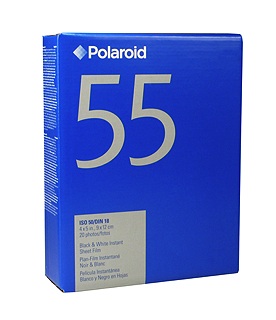 "Polaroid
and others have missed a trick though." says John, and continues, "Although Type
55 was never going to look that good in an accountants eyes, although I believe
it was profitable at the time the company ceased to be, it was invaluable to the
like of the University, as it saved so much time and hassle." The instant result
meant you knew straight away if you had the framing, lighting, and exposure all
spot on, but negative was more fragile than conventional film, and you had to
swipe it with a stick of Sodium Sulphite chemicals to fix it. However when first
produced, the film was good enough for Ansel Adams to use to test his
masterpiece compositions before exposing a 10x8 glass plate. (Ansel Adams was
actually consultant for Polaroid and the instigator of Type 55 film production,
following a request to the great Dr Edwin Land himself.) "Polaroid
and others have missed a trick though." says John, and continues, "Although Type
55 was never going to look that good in an accountants eyes, although I believe
it was profitable at the time the company ceased to be, it was invaluable to the
like of the University, as it saved so much time and hassle." The instant result
meant you knew straight away if you had the framing, lighting, and exposure all
spot on, but negative was more fragile than conventional film, and you had to
swipe it with a stick of Sodium Sulphite chemicals to fix it. However when first
produced, the film was good enough for Ansel Adams to use to test his
masterpiece compositions before exposing a 10x8 glass plate. (Ansel Adams was
actually consultant for Polaroid and the instigator of Type 55 film production,
following a request to the great Dr Edwin Land himself.)
Copy job workflow methods will vary depending on a variety of circumstances,
including the type and size of the medium to be copied, what you require as the
end result in terms of output, the camera and lighting you are using, etc. etc.
If you look at almost any image of a magazine or book for sale on eBay while
using the internet thing the young people speak of, and you can see how total
ignorance of any copy technique results in fuzzy, oblique angle,
reflection-infested images which beggars belief that the seller thinks the image
is good enough to sell the item. Both the Leitz Reprovit, [I wish I had one.
Ed.] and the Polaroid MP-4, along with other copy-stand setups such as provided
by Kaiser, Durst and Hama et al, give you a good start on the road to
parallel, in-focus, lit-from-45°, and sharp results. 5x4"
brings its own issues. Uneven light shows up more, exposure needs to be spot-on,
especially in a pre-Photoshop era, and dust-free is a good thing, lest printed
hairs look like tree-trunks in the final print.
So what is the solution? [No pun intended. Ed.]
Well, aside from investing £30,000+ in a digital Hasselblad setup to provide decent quality copy results - there's not a lot you can do. Perhaps one day Lomography or Fujifilm might come out with a Type 55-alike instant film. They have both achieved so much already. (There was a 55-like film stock manufactured and available through a company called New55, but it seems to be out of production.) ■
ACPi Team
If you know of any caches of Polaroid Type 55 film stock, or perhaps you have a spare Leitz Reprovit which could go to a good home (Eds), then do let ACPi know at articles@acpimagazine.com. Likewise, if you have a comment, opinion, correction or addition to this article - please let us know at the same email address. |

Books on Archiving | Books on Museums | Books on Microfilm
An intelligen Limited business

ACPi is a wholly owned
trading name of intelligen Limited. A company registered in Scotland. SC406750.
Registered Office: 13 Cairds Wynd, Banchory, AB31 5XU, United Kingdom
